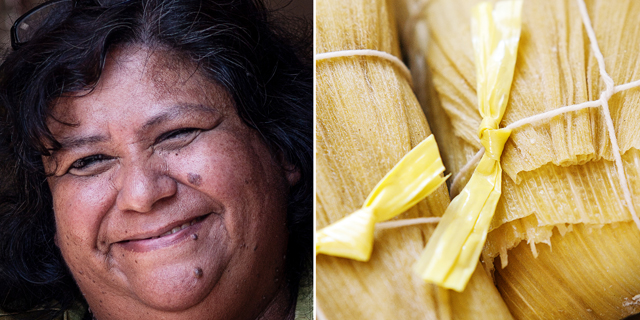One month ago I ate the best tamale in the world. Though I’m no expert, and this particular tamale wasn’t made out of the standard stuff, it’s hard to imagine it getting much better than this. It was like a Zen tamale, enlightened, completely at peace with every subtle flavor going on within its being. With little hints of lime, and an airy and lightly elastic texture, it was a perfect balance between sticky and crumbly, and left a long, subtle herbal finish. I only just stopped short of swirling, nosing, and spitting it.
For this reason, María Zuñiga is widely acknowledged to be the Queen of Tamales in Peru and her family business has been a hit in the last four editions of Mistura, Peru’s world-famous culinary festival. They offer 23 varieties of tamales and humitas, ranging from the super-powered Incan tamale of quinoa and kiwicha, to one of maíz morada (the Peuvian purple corn) and even to pisco sour or chocolate. The curious circle, sample, and fall in love.
It all started with her mother’s recipe for chickpea tamales – the same recipe which won me over at first bite — and it has not changed in the intervening 55 years. At the time she was selling her wares in the street, but a friend introduced her to the high society tea parties of Lima in the fifties and they couldn’t get enough of her unique creation. From there the business grew into a well-known catering service, selling tamales and a variety of classic Peruvian criollo dishes.
María followed on from her mother and began exploring the possibilities of these little wrapped delights, elevating them to a gourmet level. She has become a serious investigator of the long and complex history of food in Peru and in her cooking tries to ‘rescue’ old traditions and recipes. Her classic tamales are made of a traditional corn from Andahuaylas and that distinctive orange color comes from achiote, a spiky seed pod that cracks open to reveal bright red seeds which are ground into a paste traditionally used as a dye and paint.
Last year at Mistura she launched her asparagus tamale, “Peru has some of the best asparagus in the world, I had to do something with it,” she smiles. Mistura 2013? Watch this space.
Next, Zuñiga share’s the recipe for the original chickpea tamale and have a brief chat with TLK…
[ pagebreak ]TLK: What inspires you when creating new tamales?
MZ: I am inspired by the fact that Peru is a country that has so many ingredients and products of high nutritional value that are still unknown outside of Peru. The world should have the chance to get to know our amazing natural wealth.
TLK: Is there a cook who inspires you?
MZ: The memory of my mother inspires me to take on new challenges. Her love for cooking, the excellence with which she worked and the respect for the people who flocked to it, have been for me the fundamental pillars to inspire me to continue her legacy.
TLK: A favorite cookbook?
MZ: Eden.pe (A new book by Gaston Acurio and Ferrán Adría about key Peruvian ingredients, it includes recipes by the very best chefs in the world, from Copenhagen, to Tokyo to Sao Paulo.)
TLK: Can you name a favorite ingredient? Something that makes you happy to use in the kitchen.
MZ: Ají amarillo and good Peruvian pisco.
TLK: Three spices that you always have in the kitchen?
MZ: Spices that are never missing: garlic, aji mirasol, aji colorado.
TLK: Your favorite place to go eat in Lima?
MZ: My favorite place to eat in Lima is the Food Court in the Parque de la Amistad in Surco, because not only has great food but as a place it is picturesque; you can relax and forget the world.
TLK: Favorite Peruvian city or town to visit and eat?
MZ: Definitely Cusco, it is a magical place to visit. And eating in Cuzco, you can find great, organic ingredients and also a variety of Andean herbs with special medicinal properties.
TLK: Your best food memory?
MZ: The best memory I have is of a dish I ate in Piura; it was a ceviche de conchas negras (black scallops) and prawns. I have never tasted such an exciting combination, I have never forgotten it.
(Note: The ceviche de conchas negras is one of Peru’s greatest delicacies, but these days are severely overfished despite seasonal bans and should not be ordered.)
Next, Zuñiga share’s her famous chickpea tamale recipe.
[ pagebreak ]- 1/2 pound of chickpeas, soaked
- 3 ounces cilantro, processed
- 1 cloves of garlic, ground to a paste
- 2 ají Amarillo, veins and seeds removed, ground to a paste
- 1 1/2 tablespoons of vegetable oil
- 1 large chicken breast (1/2 pound), parboiled and shredded
- 2 large eggs, hard-boiled
- 4 black olives, pitted and halved (optional)
- 8 maize leaves, dried
- Sea salt to taste



![Making Mealtime Matter with La Familia: Easy Sofrito [Video]](https://thelatinkitchen.com/wp-content/uploads/2015/10/sofrito-shutterstock__0-500x383.jpg)
![Easy Latin Smoothies: Goji Berry Smoothie [Video]](https://thelatinkitchen.com/wp-content/uploads/2015/12/goji_berry-shutterstock_-500x383.jpg)
















![Fun and Fast Recipes: Fiesta Cabbage Salad [Video]](https://thelatinkitchen.com/wp-content/uploads/2015/11/fiesta_cabbage_slaw-shutterstock_-500x383.jpg)









